Hair Transplant: Should You Get One? (What You Need to Know)
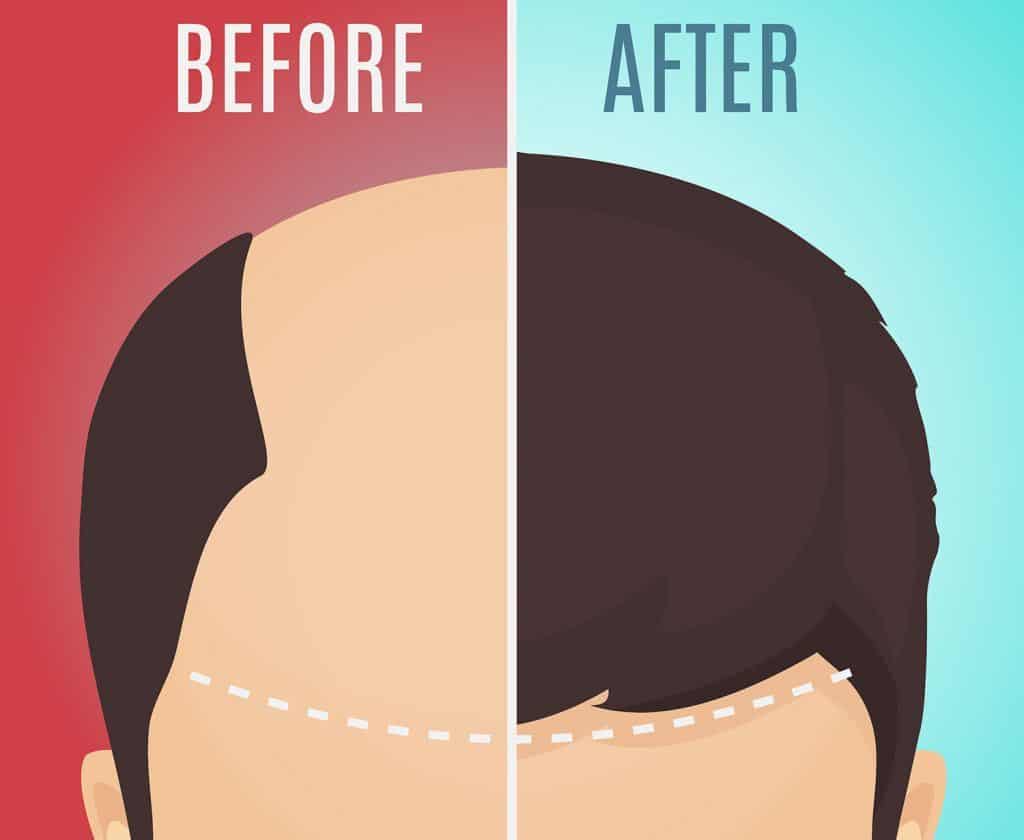
It wasn’t that long ago that getting a hair transplant was considered a bit, well, out there. A certain stigma came attached to the procedure – and with the men who received one – and false notions of the effectiveness of hair transplants abounded.
But the bottom line is that many men, and women, choose to fight back against male and female pattern baldness.
Perhaps they don’t like the results they’re getting from other strategies, including topical solutions that you’ll find in every supermarket or pharmacy shelf.
Besides, hair transplants have evolved tremendously over the years, and the skilled surgeons who perform them continue to set the bar higher for exceptional results.
So, if you’re considering a hair transplant, this guide’s for you. We’ll go in-depth to talk about hair transplants, the most common procedures, up and coming technology, and much, much more.
We hope to clear up any confusion you may have about transplants while helping you decide if one is right for you.
Here’s Why You’re Losing Your Hair
Millions of men and women across the world are losing their hair, or experience hair loss to a lesser degree. This is completely normal, because it can be found in over 90% of adults over the age of 35.
While it doesn’t seem as though you will lose any more hair than you already have, this doesn’t mean that it won’t cause problems for your self-esteem; or make things a little harder socially, especially in the workplace. The main question on top of everyone’s mind when it comes to if they should get a hair transplant is if it works.
If you’re considering a hair transplant, the chances are you understand a thing or two about hair loss. But it doesn’t hurt to cover the basics of hair loss and some of the reasons for it.
1. It’s all in your genes man
Many men are genetically disposed to experience hair loss. If you’re father or grandfather went bald, the odds are that you may, too. It’s all in your wiring, and there’s not a lot you can do about it, unfortunately.
It’s the same reason some men are short and others tall. You need only to look at your family lineage to have an idea of the odds of you going bald as you get older.
2. You’re a man, not a woman
Men are more likely to experience permanent hair loss than women. Studies show that 70% of men lose their hair, compared to 40% for women. To be more specific, men have a better chance of experiencing androgenetic alopecia – better known as male pattern baldness.
MPB starts with hair loss at a man’s temples and moves backward to form a distinctive “M” shape. But you can also experience hair loss at the crown of your head, as well.
3. Another dreaded acronym (DHT) and its role in hair loss
DHT stands for dihydrotestosterone, which is a by-product of the hormone testosterone. DHT shrinks hair follicles and makes it difficult for them to thrive.
Because testosterone constantly produces DHT – but at genetically-determined rates that may differ from male to male – men are more at risk for suffering hair loss.
Don’t be quick to bash DHT’s role, however, because it’s responsible for many important male characteristics such as body hair, muscle mass, a deeper voice, etc.
4. The 3 hair growth phases and how they affect hair loss
Having a better understanding of hair loss includes knowing the three phases of hair growth: anagen, catagen, and telogen.
- Anagen, the first phase, is when hair is growing. This phase may last for several years, depending on your genetics. When the anagen phase ends, the hair stops growing.
- Catagen is a transitional phase that follows anagen. During the catagen phase, the bulb at the bottom of hair follicles detaches from the blood supply and moves upward. The hair follicle shrinks to allow the upward push and becomes less stable. The catagen phase typically lasts about two weeks, if not less.
- Telogen represents the phase when hair follicles compromised during the catagen phase fall out, and your hair remains in the telogen phase longer as you get older. Which leads us to our next point:
5. Getting older means losing your hair
Aging causes our bodies to change in a variety of ways, and a man’s hair is part of those changes. Our hair thins as we get older, the anagen phase of hair growth becomes shorter, but – again – each person’s pace of age-related hair loss has a lot to do with genetics.
There are other reasons for hair loss, including medical conditions such as alopecia areata that causes hair to become patchy, or scalp infections. Some medications and supplements may cause hair to fall out, while radiation therapy also has an impact.
Meanwhile, lifestyle factors such as diet, smoking, alcohol use, and stress may hinder hair growth.
What Are The Different Types of Hair Transplants?
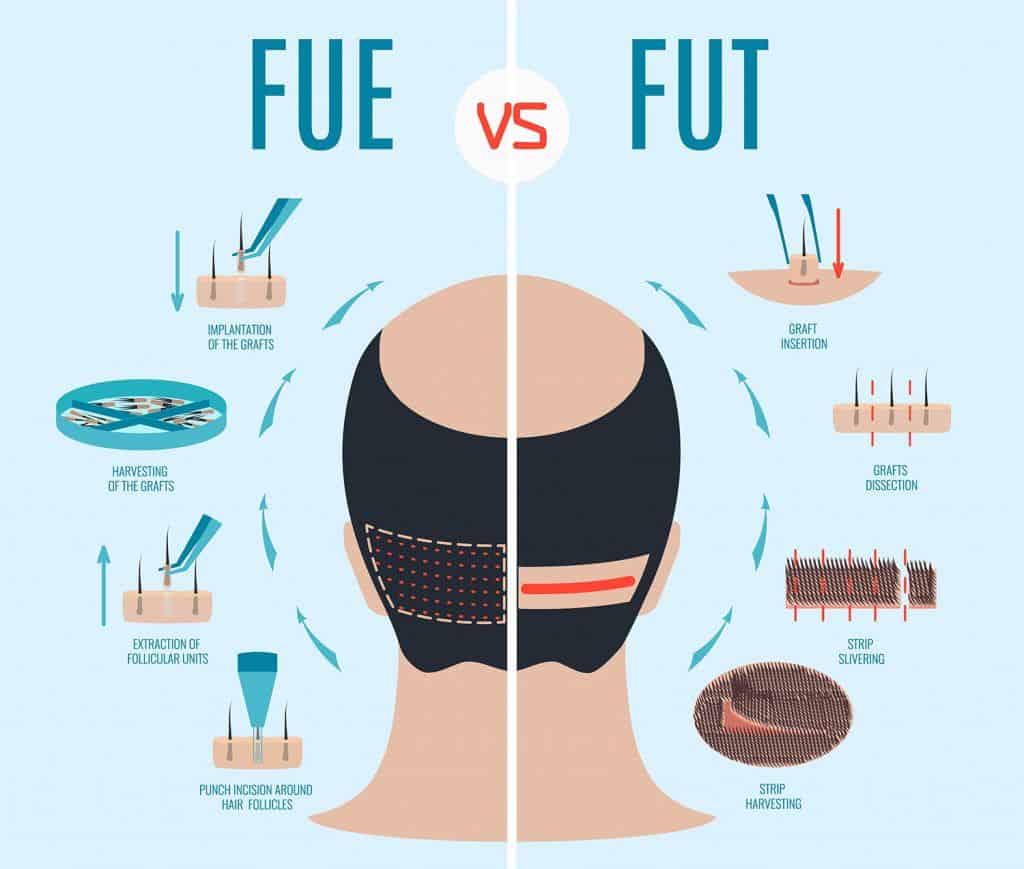
Most patients choose one of two methods – Follicular Unit Extraction (FUE) and Follicular Unit Transplantation (FUT), although there are other methods, as well as promising new technology that could become relevant in the future.
Let’s start with FUE and FUT procedures, the two most common types of hair restoration.
1. FUE surgery – What it is, its advantages and disadvantages
In both FUE and FUT procedures surgeons harvest hair follicles from an area of the head or body and transplant them to the area of the scalp where hair is thinning or falling out.
So, how does hair transplant work?
An FUE hair transplant involves the extraction of follicles from a larger donor zone, which maximizes the number of available grafts. Follicles are removed individually with a small, specialized cutting device.
Surgeons use a local anesthetic to numb the area of extraction and the process is painless.
In both FUE and FUT surgery, tiny sites are created using fine blades and needles for where the grafts from another part of the head are inserted. Because FUE involves the extraction of individual hair follicles, the surgery is tedious and takes longer.
In many cases, surgeons and clinics split an FUE procedure into multiple, shorter sessions.
The advantage of FUE, however, is that no large cuts or stitches are needed. There’s no linear, more noticeable scar, and your recovery time is quicker than with a FUT procedure.
It’s important to note that the number of available grafts – in both FUE and FUT – vary from patient to patient. But FUE potentially has more possible grafts because hair is taken from a larger area since there are no visible scars left behind.
There’s only a finite number of available grafts in both FUE and FUT surgery, and multiple procedures deplete the donor area over time.
So, who would most benefit from the FUE method?
- Men and women with smaller areas of baldness
- People who prefer shorter hairstyles
- Patients who prefer less-invasive procedures and don’t want cuts or stitches on the scalp.
- People who lead active lifestyles, including athletes.
- Patients who prefer and need a shorter recovery period.
There are some disadvantages to the FUE method, including:
- The entire donor area must be shaved, in most cases. The area includes the sides of your head and the back of the scalp, which isn’t as much of an inconvenience for men have shorter hairstyles. In less extensive procedures – typically 1,000 grafts or less – patients may be able to keep their longer hairstyle.
- The grafts extracted during FUE surgery are often more fragile than those extracted during FUT. An FUE graft includes the hair follicle, bulb, and some of the surrounding tissue, but not the protective dermis and fat that’s harvested from a FUT procedure.
- An FUE procedure tends to be more expensive than FUT.
There are also steps you’ll need to follow before FUE surgery (we’ll talk about post-surgery aftercare a little later), such as:
- Don’t take aspirin, vitamin E, or multivitamins 10 days before the procedure. Aspirin inhibits the function of platelets that help stop bleeding.
- Don’t drink alcohol or take an anti-inflammatory medication three days before surgery. Also, limit your exposure to the sun.
- If you color your hair, make sure you have it done within three days of your procedure to provide better visualization of the hair.
- Refrain from smoking one week before your procedure as it may delay healing.
- Taking 1000 to 2000 mg of vitamin C before surgery may help with healing.
2. FUT surgery – what it is, its advantages and disadvantages
FUT, also known as strip harvesting, involves the extraction of a strip of hair from a part of the head in which hair is growing. The surgeon then uses a microscope to divide individual hair follicles into small groups before inserting them into bald areas.
The donor zone for a FUT hair transplant typically is the sides and back of the scalp. The surgeon can harvest more hair follicles in one strip than with other types of hair transplant procedures, and more hair is “moved” in one sitting than with FUE.
Each graft contains oil (sebaceous) glands, nerves, a tiny bit of muscle, and some fine hairs. Surgeons place the grafts into tiny incisions made on the scalp in a single session.
Again, the primary advantage of a FUT procedure compared to FUE is that larger areas of baldness are covered in fewer sittings – and often in one session. That makes it more suitable for patients who have significant areas of baldness.
There are other advantages, however, including that FUT tends to provide a more natural-looking head of hair once the healing is complete, and that it’s more affordable than FUE.
Some disadvantages of the FUT procedure include:
- Noticeable scarring in the donor area.
- A longer recovery period.
- The risk of local inflammation and infection if proper care isn’t taking during and after surgery.
- Patients need to refrain from strenuous activity for one month following the FUT procedure.
Among the steps you should take before a FUT hair transplant are:
- Don’t cut your hair within two weeks of the surgery and leave your hair a half-inch long on the back and sides to provide a covering for sutures.
- Don’t take anti-inflammatory medication for one week before the procedure.
- Limit your sun exposure to ensure that your scalp isn’t sunburned when you arrive for your initial FUT session.
- Let your surgeon know if you’re taking blood thinners or broad beta-blockers.
- Refrain from smoking and drinking at least a week before your transplant. Both habits may inhibit healing.
- As with an FUE transplant, color your hair within three days of surgery to provide better visualization of your hair.
3. Other hair transplant techniques: The role of robots
A promising 21st-century technology involves the use of robotics to perform hair restoration procedures.
While the technology isn’t new to this century, it has taken a dramatic leap forward, and many of the top hair transplant surgeons in the world have adopted it.
FUE robotic hair transplants involve the use of a 3D image-guided program with a robotic arm. The physician controls the system, which also includes video imaging, live motion tracking, and a user interface.
The major advantage of this technology is that it’s much faster than labor-intensive manual transplants.
There are other advantages, including more consistent graft extraction, but make sure the physician you choose has plenty of experience with the technology.
4. Stem cell hair transplants – the wave of the future?
A stem cell hair transplant represents the potential frontier of hair transplants and is still in the development stage. It’s similar to traditional hair transplants except that a small skin sample is taken from the donor area of the scalp instead.
Specialists replicate the follicles found in the skin sample and implant them back into the scalp – both in the area of hair loss and the donor zone.
Several research teams are working on stem cell hair loss treatments and a transplant was completed successfully in 2017 by Italian researchers.
While procedures may differ slightly among those developing them, they’re all based on growing new hair follicles in a lab setting.
For now, there’s no guaranteed outcome of stem cell procedures, but that may change in the next few years.
5. Platelet-rich treatments
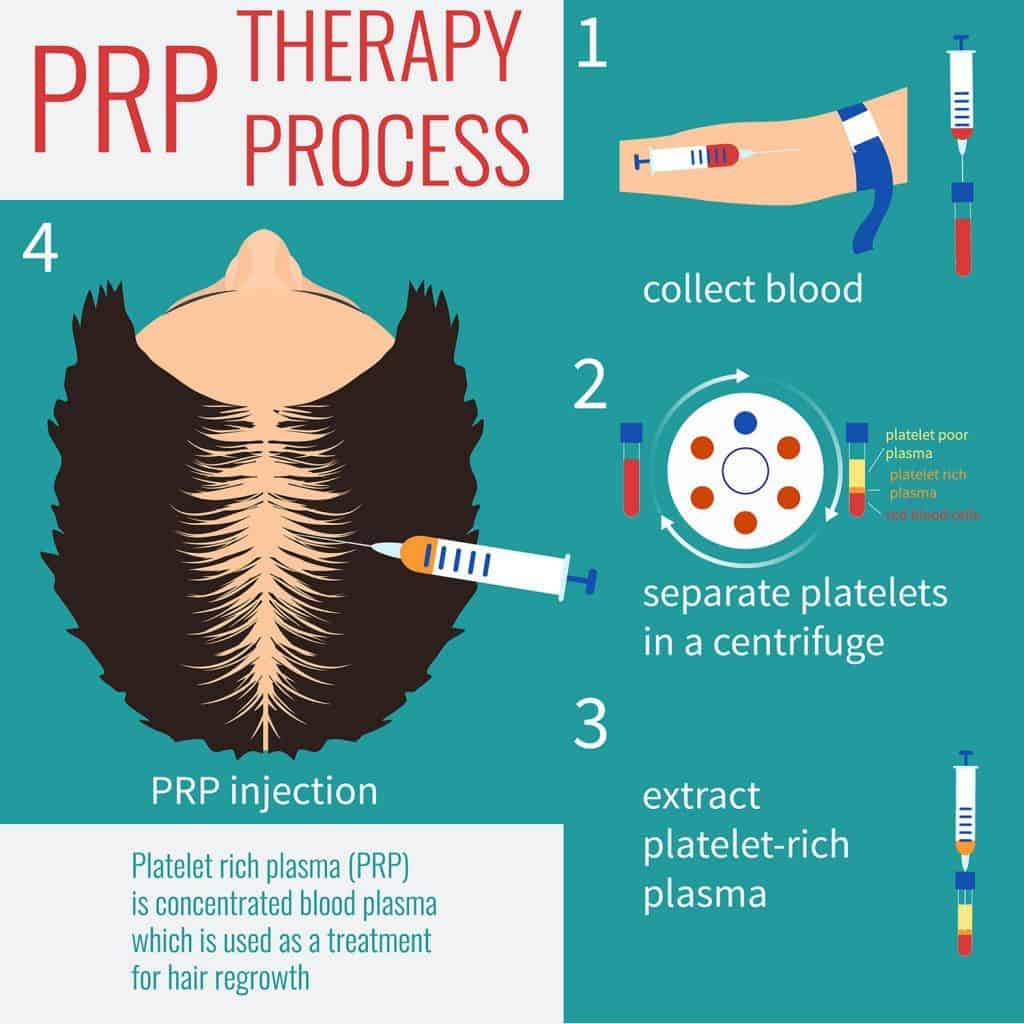
Recent studies show that PRP can serve as an effective, safe procedure for treating hair loss in men and women.
PRP is sometimes used in conjunction with hair transplant surgery to help reduce swelling and pain, to increase hair thickness, and also as a stand-alone hair growth procedure.
Here’s how it works:
- A specialist draws blood from the patient’s arm and places it in a centrifuge that separates the blood’s platelets from other red and white blood cells.
- The platelets are activated by mixing them with calcium chloride, thrombin, and (sometimes) collagen.
- Activated platelets, when injected back into the body, have several naturally-occurring substances that can stimulate cell growth, healing, as well as epidermal growth and connective tissue growth.
The use of the patient’s blood and tissue during PRP treatments enables physicians to harness their healing power to promote natural hair growth without having to move hair from one part of the scalp to another.
Deciding Whether to Get a Hair Transplant – The Pros and Cons
Going bald is, for many men, a disheartening, even traumatic experience. All that hair that helped you rock your final year of high school photo is gone forever and with it – you may think – comes the end of your most handsome, virile years.
Not so fast.
In many countries, including the U.S., becoming bald isn’t the punch to the gut it used to be, and many men prefer to shave their head rather than wait for the inevitable day in the not-so-distant future when it all falls out.
Some women say that a man with a bald man seems more masculine, strong, and even dominant.
Keep in mind, however, that we – and they – are talking about men who are completely bald (such as Bruce Willis and others), not men who are in various stages of hair loss and trying desperately to make it seem not so bad.
And whatever you do, guys, don’t compensate for hair loss by doing a “comb-over” to cover the bare spots on top of your head. There’s probably a very small percentage of women who find a comb-over attractive, and good luck finding one.
But rocking the bald look successfully, in which you give off a strong, masculine vibe, means also having an attractive build and dominant air. If not, a bald head may make you seem old and less virile.
All that said, we’re not encouraging you to go bald because it might help make you seem more attractive to women. Our focus is on hair transplants and why you should consider getting one. There are some pros and cons.
Pro:
- A nice head of hair is attractive to women
True, we’ve just discussed that women today find (some) bald men attractive. Hell, bald is even beautiful, or so the saying goes. But the fact remains that a woman’s perception of a man who has a full head of hair is almost always positive.
A study by John Hopkins University showed that men with a natural head of hair were perceived 1.1 years younger than their actual age. Meanwhile, men who had a hair transplant appeared 3.6 years younger.
The same study also showed that men with a nice head of hair also scored higher in categories such as attractiveness, successfulness, and approachability.
Con:
- A nice head of hair doesn’t necessarily raise your confidence
Even if you get a hair transplant and feel more confident, it still comes down to your overall confidence. If you’re a confident person bald or not, the chances are good that you’ll remain confident in all areas of your life.
But if your hair loss makes you feel less attractive, your feelings of inadequacy may become more obvious.
Besides, accepting your baldness may also raise your confidence level. In turn, that boost of confidence helps you withstand societal pressure.
Pro:
- A hair transplant is permanent
The results of a hair transplant don’t just last for a year or two, but they last forever. Your newly transplanted hair won’t fall out. However, any hair on your head that isn’t part of a transplant continues to fall out at its normal rate.
Con:
- A hair transplant is surgery, after all
Make no mistake, a hair transplant is a surgical procedure and the mere thought may cause a spike in your anxiety levels. Then again, it’s not a surgical procedure in the same sense of, say, open heart surgery – not even close.
The good news is that most clinics offer patients a light sedative and you’ll be awake the entire time.
Pro:
- A hair transplant looks natural
A hair transplant isn’t like wearing a toupee or wig. Instead, you’ll get a natural-looking head of hair that’s subtle and not overtly obvious.
The bottom line is that you’ll love the hair transplant results, especially when a highly-trained, experienced surgeon performs the procedure.
Con:
- You’ll need recovery time after a hair transplant
Like with any surgical procedure, a hair transplant requires the proper amount of healing time. Most surgeons recommend that patients wait seven to 10 days after the procedure before resuming normal activities.
Among some things you can do to aid the healing process is to protect your newly-transplanted hair from direct sunlight (for up to three weeks) and to avoid tugging, pulling, or scratching your hair.
Pro:
- Your new hair needs no specialized treatment
Once the recovery period has passed you can resume your normal hair care routine – from shampooing it, to having it cut and styled, to brushing it and having it colored.
Con:
- You need to continue your current hair loss treatments
You may believe that having a hair transplant allows you to stop using hair growth/hair loss treatments such as Finasteride (Propecia) and Minoxidil (Rogaine). Not so fast.
While the decision may vary from case to case, most transplant specialists recommend that you continue to use hair loss products. There are a few reasons why:
- While a hair transplant restores hair, and its natural growth, on the part of the scalp where the transplant takes place, the rest of your non-transplanted hair continues to shed at its normal rate. The problem is, you’ll have parts of the scalp where hair is thriving (from the hair transplant) and others in which hair is shedding. The result is hair that looks uneven and patchy.
- Some surgeons believe that using Minoxidil during post-surgery aftercare helps the transplanted hairs to grow faster.
There’s no need to use products such as Propecia and Minoxidil if you’ve lost all of your hair. But you should consult with your doctor to make sure you have enough donor hair available to cover your scalp.
Pro:
- A full head of hair may help you in your career
Several studies indicate that “attractive” men and women receive more advances and pay raises at work. Many managers prefer people who look young and energetic, and we’ve already discussed how men with nice hair appear younger.
Con:
- What qualifies as “attractive” today may change
Fashion styles come and go, sometimes in what seems like a matter of months, as do people’s perceptions of what qualifies as physically attractive.
A couple of centuries ago, people considered women with full hips and a rounded stomach desirable because it indicated wealth. It only makes sense – you can eat enough to get chunky, therefore you must have money to afford all that food.
Even just a few decades ago, women with hourglass figures captured their fair share of the Hollywood.
The bottom line is that what’s considered attractive today always changes, at least somewhat. It’s anyone’s guess whether a man with a full head of hair still earns sizable attractiveness points 100 years from now.
But, in the society we live in now, having a nice head of hair certainly doesn’t hurt. Not that a bald man can’t garner his share of attention, but it does help if they have the kind of masculine features and head shape that are compatible with a bald head.
Here’s What You’ll Pay For a Hair Transplant

But – and there’s always a “but” – you’ll also pay a significant amount of money for your new head of hair and the surgeon’s specialized services.
A hair transplant typically ranges in price from $4,000 to $16,000, in most cases, and most insurance companies don’t cover the costs of the transplant because they classify it as cosmetic surgery.
The cost of a transplant varies from clinic to clinic and depends on the patient’s level of hair loss. Many facilities that offer FUT or FUE (or both) methods charge per graft, and each graft typically consists of one to four hair follicles.
Other factors also affect the price of a hair transplant procedure, including:
- The type of procedure you choose – An FUE transplant usually costs more than FUT.
- Where you live – The cost of living where you reside and the number of surgeons in your area can influence what a surgeon charges.
- The surgeon’s skill – The better the surgeon, the more expensive your procedure may be.
- The amount of hair transplanted – Transplanting hair on the entire scalp costs more than treating smaller patches.
Other factors may affect your overall cost, including travel costs if you choose a specialist who doesn’t have a clinic in your area. Plus, there are aftercare costs such as the price of pain medication – if you need it – and antibiotics and anti-inflammatory medicine.
While you may feel tempted to find the most inexpensive surgeon and treatment, do keep in mind that a cheaper option may result in a less-than-satisfactory transplant.
And, let’s face it, a cheap-looking transplant that looks unnatural can result in a lot of embarrassment.
We recommend that you don’t skimp on the money but search for a skilled surgeon in a price range that works for you. On the other hand, a higher price doesn’t guarantee a more skilled surgeon, so do your research carefully before you choose a clinic.
Hair Transplants: Some History & Everything Else You Need to Know
Everything starts somewhere and hair transplants are no exception. While the roots – no pun intended – of modern hair restoration surgery began in the 1930s in Japan, the world’s quest for a fuller head of hair didn’t start there.
Indeed, snake oil salesmen of the 1800s, particularly those in America’s Wild West, had all sorts of hair loss “cures” and were more than willing to sell them to any sucker who crossed their path.
Those salesmen had a tough job and a set of iron cajones considering that their potential client list included hardened outlaws and other nasty folks who were quick to draw their guns when irritated.
No, not an easy gig, and the fate of those early hair restoration con artists depended on their ability to sell grease that may or may not have made hair look thicker.
Treating hair loss attained more legitimate status thanks to the work of Japanese dermatologist Dr. Shojui Okuda who developed a technique for restoring hair on burn victims.
Another Japanese doctor later developed a method that used smaller hair-bearing skin grafts to, oddly enough, replace lost pubic hair on female patients.
New York dermatologist Dr. Norman Orentreich performed the first hair transplant surgery in the U.S. in 1952 on a man suffering from MPB.
Orenteich’s methods laid the groundwork for modern hair transplantation, and by the 1960s the procedure had found a permanent place in the world of cosmetic surgery.
The development of modern hair transplant surgery included large plug technique, in which surgeons used skin grafts (plugs) of multiple hair follicles. The procedure’s main downside was the extremely slow growth of transplanted hair, however.
Minigrafts and micrografts, consisting of hair grafts of three to six hair follicles, helped define hair transplant surgery in the 1980s, while the technology of the 1990s made it possible to move a large number of grafts from one part of the head to the other.
The surgical instruments became smaller and minimized trauma to the skin tissue.
Today, thanks to the advent of FUE, FUT, and other procedures as well as evolving technology, hair transplants remain the gold standard for treating hair loss.
Some common questions people have about hair transplants

Will my hair transplant look natural?
A hair transplant completed by a qualified, trained surgeon will have a look so natural that it may fool your hair stylist.
That’s another reason why it’s important to choose your surgeon and clinic carefully, because results can vary widely from one procedure and clinic to another.
Will people notice my hair transplant?
This question is closely related to #1, but is still relevant because hair transplant surgery does leave tiny scabs around the incisions. While the scabs usually fall off within a week, they’re noticeable if not concealed by existing hair.
Can I get a hair transplant at any age?
Male pattern baldness doesn’t wreak havoc only on older men. It can also happen to men in their 20’s – and even earlier – and many young men today consider hair transplants a viable option.
That’s understandable considering that men who start losing their hair earlier in life have a higher risk of going bald later.
But most surgeons suggest that men wait at least until their mid-20’s before considering a hair transplant over other options. Why? It comes down to a few things:
- The donor area, or “zone,” of a younger man’s head may not be stable. That is, you need a permanent zone to draw hair from because there’s no guarantee that the donor hair will stay put while the donor area continues to thin.
- Because a man’s hair loss continues into his 30s, and even beyond, a man who receives a hair transplant in his 20s will likely need additional treatments as he ages. It’s hard to determine the long-term stability of donor hair when patients are very young.
- A hair transplant is most effective when used to restore a normal adult hairline, not an adolescent hairline that’s still changing.
- Because it’s difficult to tell the eventual pattern of hair loss in a younger person, a transplant could lead to an unnatural appearance as you lose more hair.
Is hair transplant permanent?
Yes, hair transplants are considered permanent and it’s one of many reasons why you may want to consider having the procedure to deal with hair loss.
Hair transplants are permanent because the hair obtained from the back of the scalp is genetically more durable than hair found on other parts of the scalp.
However, the transplanted hair is subject to the effects of aging as any other part of the body, and becomes finer and turns gray as you get older. But in many patients and surgeons report that transplanted hair turns grayer more slowly than existing scalp hair.
Is hair transplant painful?
You’re not alone if you have some anxiety about experiencing pain during a hair transplant.
Fortunately, the vast majority of patients report feeling no pain during an FUE procedure. Your surgeon injects a mild anesthetic into your scalp before the surgery; there may be some mild discomfort during the injection and some discomfort post-surgery.
FUT surgery is a bit more painful but, again, many patients say discomfort is minimal. Medicine is sometimes prescribed to deal with post-transplant pain.
Restoring scalp hair isn’t the only game in town these days, either. Beard transplants – which we’ll compare with hair transplants a bit later – have become popular among men who, due to genetics and other factors, have trouble growing a full beard.
Like hair transplants, a beard transplant relies on FUE and FUT technology to move hair from one part of the body to the other. The result is a permanent, natural-looking beard.
Some Do’s and Don’ts of Hair Transplant Aftercare
What you do in the period right after your hair transplant is crucial for ensuring that you get the best results.
Taking the proper aftercare steps also helps you to return to your daily routines faster and to enhance your hair transplant success rate. Here’s a look at some do’s:
- Follow your surgeon’s instructions. Your surgeon doesn’t give you aftercare instructions just to hear himself or herself talk. There are general aftercare guidelines you should follow, but the instructions given by the person who performed your transplant are of utmost importance.
- Keep your scalp dry the day of and day after your transplant to allow the skin to start healing.
- Keep the area around the scalp as clean as possible during recovery. You may feel soreness and numbness in the graft area, but don’t put anything on your scalp that hasn’t been approved by your surgeon.
- Take painkillers if you feel pain and discomfort in the hours immediately after surgery. The general anesthetic given you before the procedure will have worn off and you may have some soreness and swelling. Contact your surgeon if pain and swelling persist, but those symptoms are normal post-surgery side effects.
- Wash and shampoo your hair a day or two after surgery to clean scabs around grafted hairs. This prevents the scabs from damaging hair follicles and thwarting hair growth. However, wait four or five days after the procedure to wash your hair under a showerhead; hand wash it instead with water collected from the tap or other source for the first few days after surgery. Ask your surgeon for recommendations of shampoos you can use safely.
- You can use an ice pack to relieve swelling or soreness during the first week following surgery but don’t place the pack directly on the grafted area.
- Have someone available to drive you home after the procedure because you may still feel the effects of the anesthetic applied before the surgery.
Some things you shouldn’t do after your transplant include:
- Exposing your head and transplant area to direct sunlight for several days. If you need to be in the sun, wear a hat for protection.
- Don’t pick at the scabs on your newly-grafted scalp because doing so may cause the grafts to fall out.
- Don’t drink or smoke for several days, if not longer, after the procedure. Drinking and smoking interfere with the blood flow needed to heal your transplanted area.
- Don’t work out or play sports for around ten days after surgery. Try not to engage in any activities that cause excessive sweating because it may increase your risk of getting an infection. Avoid playing contact sports – such as basketball and soccer – for the first month after surgery, although a short routine walk or jog is often OK.
You’re Not Alone – Celebrities Who’ve Had Hair Transplants
If you decide to get a hair transplant you’ll join a club whose member list increases with each passing year. It’s also a club inhabited by many notable people (not that you’re not notable), including the following well-known gents:
1. Wayne Rooney

2. Elon Musk

3. John Travolta

Is the transformation the result of a transplant? Most observers say it is.
4. Matthew McConaughey

5. Elton John

6. David Beckham
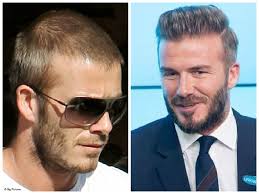
7. Sean Penn
Penn’s once admirable head of hair began to fall out as he got older – surprise, surprise – but he, allegedly, opted for a hair transplant.
8. Bono
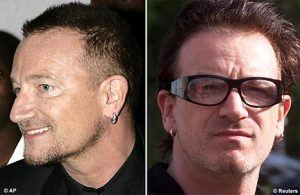
How a Hair Transplant is Different – and Similar – From a Beard Transplant
The surge in popularity of beards in the past several years has also seen a rise in the relatively new science of beard transplants.
While many men desire a full, wondrous beard, not all of them can achieve it because of a variety of factors, including genetics. But beard transplants offer a solution for those who can’t get the beard they desire on their own.
Like a hair transplant, the hair used for a beard transplant is moved from one part of the body to another – in this case, the area of the face where a beard normally grows.
While the procedures used for each are similar, there are differences between beard and hair transplants, however.
The characteristics of scalp and beard hair differ, for one. Beards and mustaches consist of single-hair units that don’t begin to appear until puberty.
Androgens, i.e., male sex hormones, power beard growth and facial hair increases in density for new few decades, depending on the individual.
Meanwhile, as we mentioned earlier, the action of androgens (DHT) can cause hair loss on the scalp and lead to male pattern baldness. The hair follicles of some men are more sensitive to certain male hormones.
Another difference that relates to hair and beard transplants is the overall density of the hair. Facial hair has less density than scalp hair. Facial hair follicles typically are in more of an elliptical shape, as well, when compared to the more oval or circular shape of scalp hair.
Here are some more differences and similarities between hair and beard transplants:
- The procedure
While the removal of hair grafts from the donor area is similar for both beard and scalp transplants, the harvest and distribution of them are different.
If not enough hair is available in the “donor zone” (the back of the scalp) for a beard transplant, hair from other parts of the body – arms, legs, chest, etc. – is often used. But the preferred zone is the back of the scalp, where hair is particularly resistant to hair loss.
Another difference between hair and beard transplants is that surgeons use smaller incisions when transplanting hair to the facial region.
- The types of hair and beard transplants
Hair and beard transplants generally follow two methods – Follicular Unit Extraction (FUE) and Follicular Unit Transplant (FUT). We discussed both procedures earlier in the article, and both have similar advantages and disadvantages for beard transplants.
One of the benefits of using the FUE procedure for a beard transplant is that it doesn’t leave a linear scar. Tiny, white scars are left behind in the donor zone, but they’re barely visible – even if you have shorter hair.
The FUT beard transplant procedure harvests a greater amount of hair, which may make it easier to achieve a maximum, “full” look on the face.
The hair harvested during a FUT beard transplant procedure usually comes the middle of the donor zone to ensure the maximum number of grafts.
The typical full beard transplant may consist of approximately 2,500 grafts while the average number of grafts available ranges anywhere from 4,000 to 7,000.
- The cost
Beard transplants, like hair transplants, aren’t inexpensive. You may pay anywhere from $5,000 to $15,000 for a beard transplant at a reputable clinic with properly-trained, experienced surgeons.
Make sure you do your research before choosing a clinic – especially if you decide to save some bucks by going to a lower-priced clinic.
You always want to be safe rather than sorry when you decide to do something permanent, such as a hair or beard transplant.
- Your hair will fall out after a beard transplant
Say what?! Yes, it’s true: your newly-transplanted hairs fall out within three weeks of having your transplant procedure. Not to worry, however, because those hairs get replaced by hair that grows from the new grafts. Indeed, temporary shedding is simply part of the process.
- Facial hair transplants aren’t just for beards
A facial hair transplant often involves creating a fuller beard, but the procedure also works for mustaches, goatees, and sideburns. Or, the transplant may only involve filling in patchy areas of facial hair.
- The risks
The risks involved with a beard transplant include pain at the donor and recipient sites, bruising, swelling, infection – not unlike the risks of having a hair transplant.
- The result
The results for both hair and beard transplant procedures are permanent, i.e., the hair that’s transplanted is permanent. Non-transplanted hair continues to fall out for a variety of reasons, not the least of which is the aging process.
If you’re man long-plagued by a patchy beard, you’ll like that you won’t have to endure that patchiness again after you’ve had a beard transplant.
What Are Some Alternatives to Hair Transplant Procedures?
Millions of men are willing to do what it takes to prevent hair loss and regenerate hair growth.
Hair transplants incorporate ever-changing technology and offer a more permanent solution than other hair loss treatments but there are many other options available.
Let’s start with the “Big 3” of hair loss treatments – finasteride, minoxidil, and ketoconazole.
1. Finasteride, aka, Propecia

Both side effects cause many men to consider other hair loss treatments, but you shouldn’t let nightmares of a limp noodle scare you away. Why?
Because a very small percentage of men (1% or less) have experienced these side effects and, in some cases, just the thought of something affecting a man’s sex drive and his beloved tool causes things to become, well, a bit flaccid.
We’re men, after all, and “limp” is sometimes a four-letter word stronger than the rest.
All that said, don’t let Finasteride’s less-than-likely side effects scare you because you’re probably in the 99% who never experience them. OK, enough on that, let’s look at how the stuff works.
- Propecia fights hair loss by reducing levels of DHT in the body. More specifically, it works by reducing an enzyme called 5a-Reductase that converts testosterone into DHT. Propecia blocks DHT at its source and will, potentially, slow hair loss while regenerating hair growth.
- Several scientific studies show that Finasteride helps prevent hair loss at the vertex scalp – the area on the top of the head that’s slightly behind your hairline.
- Propecia blocks up to 70% of DHT and can block, reverse, or even reverse hair loss. Note: there’s some debate whether Propecia can regrow hair, although many users report hair growth when taking it. In any case, it won’t replace all of the hair you’ve lost but it can prevent you from losing more, and may even cause new follicles to sprout.
- The most common method of using Propecia is by taking 1 mg pill every day but many men use it every other day or even three times a week. You should see results in three months.
- Propecia received FDA approval for treating MPB in 1997.
- You can get Propecia from your regular doctor or dermatologist, and online. Be wary of sketchy pharmaceutical sites if buying it online, however.
2. Minoxidil
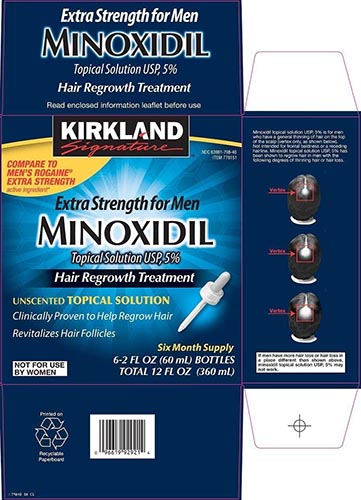
Minoxidil works by widening blood vessels and improving blood circulation to the scalp. In turn, more oxygen, nutrients, and blood reach the hair follicles to make them stronger.
It also lengthens the anagen (growth) phase of hair growth. Unlike Finasteride, Minoxidil doesn’t work as a DHT blocker.
You may know Minoxidil by the common brand name Rogaine, and it typically comes in liquid or foam versions. Minoxidil may also go by Lipogaine, Regaine (in Europe), Kirkland Minoxidil, Foligain, etc.
Lipogaine provides the added advantage of including DHT-blocking ingredients. They don’t pack the same punch as Finasteride in the DHT battle, but they do give minoxidil a bit of a boost.
Kirkland Minoxidil costs less than Rogaine and many men choose it because of its price. The main reason Kirkland Minoxidil costs less is that Rogaine supposedly uses better ingredients. But Kirkland Minoxidil is often just as effective as other Minoxidil products.
While Finasteride may be a bit more potent than Minoxidil, there aren’t potential sexual side effects with Minoxidil. You’ll also find Minoxidil practically everywhere and it’s available over-the-counter.
Great example — Rogaine Minoxidil Foam (for Men)
3. Ketoconazole
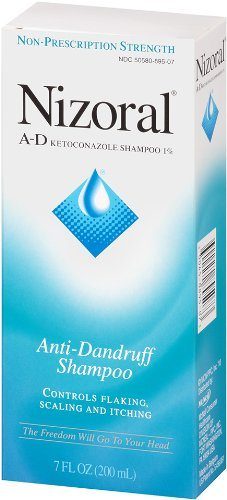
Nizoral comes in a shampoo form and its active ingredient is ketoconazole, which inhibits hair loss and MPB by inhibiting DHT and by reducing inflammation that can lead to hair loss.
Nizoral shampoo comes in two versions, 1% and 2% Ketoconazole, and you’ll probably need a prescription for the 2% version. In either case, it’s not considered as strong as Finasteride or Minoxidil, but it’s still an effective way to fight hair loss.
Here’s the other thing: you should use Nizoral in conjunction with Finasteride and Minoxidil. You won’t get the same results if you use it alone, and you shouldn’t expect hair regrowth.
Instead, you will see a slower rate of hair loss than you experienced before you started to use it.
Don’t use Nizoral, or other Ketoconazole brands, in place of your regular shampoo.
Most men use it every other day, or even just once a week, with positive results. Cut back on its use if your hair becomes brittle. You apply it as you would any shampoo, but leave it on for five to 10 minutes before washing it off.
Great example — Nizoral A-D Anti-Dandruff Shampoo
Some other hair loss treatments for men
While the Big 3 are popular among many, many men looking to for ways to fight hair loss, there are other options, as well:
Think of Dutasteride – or its “street” name, Avodart – as a stronger form of Propecia. It packs a wallop regarding DHT reduction and prevents DHT from attaching to hair follicles. You can only get it with a doctor’s prescription.
Topical spironolactone works as a topical DHT blocker. While not considered particularly strong, spironolactone is the go-to option for many users.
- Derma rollers
A derma roller works much differently than Finasteride, Minoxidil, etc., because it’s a small plastic roller with numerous tiny needles that you can use on your scalp.
The needles make small incisions on the skin (but won’t cause bleeding or even hurt) so that the skin will heal and regenerate.
In turn, the production of collagen – the most abundant protein the body and something that benefits the hair, among many other parts of the body – increases. Your skin also becomes more able to absorb nutrients.
The jury is still out regarding the effectiveness of derma rollers, but some people swear by them. To others, well, a derma roller doesn’t do a damn thing.
Great example — StimuROLLER Hair
- Scalp micropigmentation
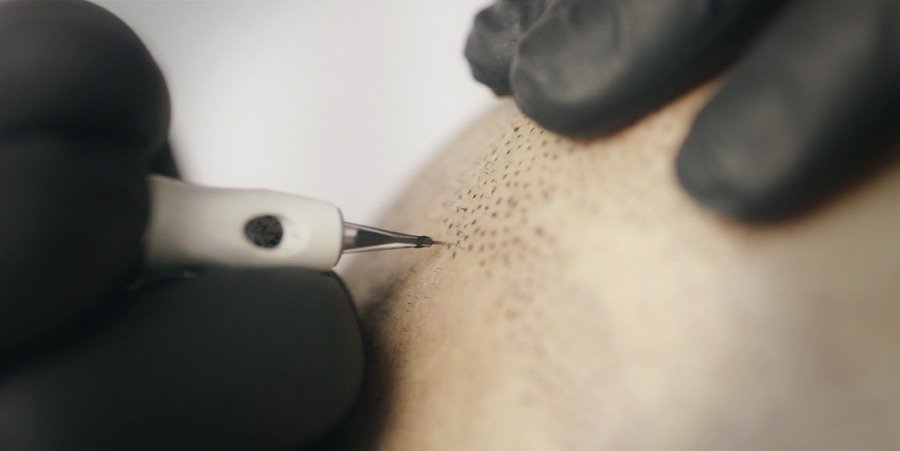
Indeed, scalp micropigmentation is a process that uses microneedles to tattoo the scalp while giving the appearance of tiny hair follicles. It’s particularly effective for adding density to areas of the scalp with thinning hair.
Trained technicians use the microneedles to layer pigment dots on your scalp. The procedure creates the illusion of a full head of (shaved) hair.
Each dot is applied into a tiny wound on the skin, and a scab forms over the wound and eventually falls off, taking some of the pigment with it.
That’s why scalp micropigmentation often requires multiple sessions to get the proper pigment shade. Technicians usually apply lighter shades first before introducing darker shades during subsequent sessions.
An initial micropigmentation procedure usually lasts from three to five hours while additional sessions typically take less time as technicians fine-tune things to get the correct blend of density and darkness.
Patients may experience some discomfort during an SMP session but the discomfort becomes more tolerable as the session progresses.
But it’s safe to say that SMP causes less pain than most tattoos, although everyone’s tolerance for pain and discomfort is different.
Most patients can return to work the day after a scalp micropigmentation procedure. They may experience a slight redness on the skin that lasts from 24 to 48 hours.
While only trained technicians perform SMP, results may vary from company to company. That’s why it’s important to do your research to find the most reputable SMP companies before choosing one to handle your procedure.
The last thing you want is a hair tattoo that doesn’t look realistic.
A scalp micropigmentation doesn’t come cheap and generally costs from $2,000 to $4,000 in the United States. But SMP is also used to conceal scars, blemishes, or other types of trauma to the skin. It’s even used to blend birthmarks into the scalp.
Another treatment option includes the use of vitamins and supplements targeted to encourage hair growth while slowing down hair loss. Vitamins such as A, B12, H, C, E, and D are important for hair growth.
Vitamin H, better known as biotin, is an essential ingredient in hair growth supplements.
Important minerals and proteins such as folic acid, iron, zinc, niacin magnesium, calcium, riboflavin, can also stimulate hair growth. Vitamins are essential to healthy hair but need help from minerals and proteins to promote hair growth.
It’s important to choose a supplement that both reduces hair loss and improves hair growth and, in every case, choose one that’s proven to block the effects of DHT.
Great example — Revita Nutraceutical Tablets for Hair Growth
- Laser combs and helmets
Some men choose laser combs and helmets to treat hair loss – while promoting hair growth – and swear by their effectiveness, but others remain skeptical.
Laser combs and helmets utilize Low-Level Laser Therapy (LLLT) to prolong the anagen phase of hair growth while also increasing blood flow to the scalp to help ward off the effects of DHT.
At least one clinical study show that laser combs produced positive hair growth results in men and women, and combs and helmets have FDA approval for safety (but for their effectiveness).
A laser comb is a manual device that you move over your scalp as it emits laser light. Laser combs are cheaper than laser helmets and treatments typically take less time.
Laser helmets, just as their name implies, involve placing a plastic shell over your head. The shell/helmet has medical-grade lasers and LEDs to radiate light energy that’s absorbed by the hair follicles.
The helmets are lightweight and fit comfortably on the user’s head. The typical laser helmet session lasts from 20 to 30 minutes.
You can use laser helmets and combs in combination with other hair-loss treatments, including Minoxidil, supplements, and hair-growth shampoos.
Great example — Irestore Laser Hair Growth System
- Toupees & Wigs
Men have covered bald spots with wigs and hairpieces for thousands of years.
They don’t have to now thanks to hair transplants and other procedures designed to conceal hair loss, as well as topical solutions such as Finasteride and Propecia, but some men still prefer wearing a toupee or other type of hairpiece.
While the popularity of toupees is waning – their use has declined by 30% in the U.S. and Asia – you’ll have no trouble finding one if that’s your thing.
And there are some advantages of wearing a toupee, not the least of which is that they cover bald spots (which is the name of the game we’re talking about here, after all).
Some toupees consist of human hair, which improves their authenticity, and are easily attached to existing hair.
You’ll also find them in a variety of styles and colors, which makes it easy to find one that fits your skin tone and style of dress, and they’re more affordable than most other methods used to deal with baldness.
Ah, but there are disadvantages, as anyone who’s seen a man with an ill-fitting toupee can attest, and you need to carefully consider your choices before ordering a toupee from an online seller:
- A toupee can fall off if not securely attached and that can create a boatload of embarrassing consequences.
- A toupee that’s not a perfect match with your existing hair is, well, way too obvious.
- Toupees need regular cleaning, and their color may fade over time, leaving spots and blotches that are way too noticeable.
- Acrylic toupees have a short lifespan; in most case, less than a year.
Wigs provide another option for men seeking solutions for their hair loss. While men’s wigs aren’t nearly as common as women’s wigs, they have come a long way thanks to evolving technology and manufacturing methods.
Many men’s wigs consist of synthetic, natural-looking hair fiber that doesn’t lose its shape or style. Lace front wigs, which are tied by hand and have a sheer lace band that goes onto the scalp, are the most popular type of men’s wigs today.
The general rule-of-thumb for both toupees and wigs is that, the better the hairpiece, the less others will notice it. Finding the right match is everything.
Conclusion
Man’s quest to cover up thinning and balding hair has gone on for ages and will continue for many years to come. While the bald look has gained widespread acceptance, the fact is that many men – and women – prefer a full head of hair.
Hair transplants represent the most overall effective method of covering bald spots, and you can’t argue with their realistic-looking results. Transplants aren’t cheap, but the right surgeon and right clinic will make your investment worthwhile.
Meanwhile, the future seems unlimited regarding new technology for dealing with hair loss. There are alternatives to hair transplants now, and it’s safe to say there will be more as researchers perfect new methods and techniques and make them available to everyone.
How about you? Have you had a hair transplant or are you considering having one? What’s your opinion of hair transplants? We always encourage your feedback, and we’d love to hear from you. Until next time, friends.

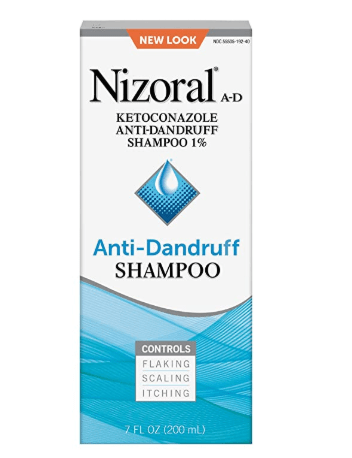



6 Comments
That’s one of the most helpful hair transplantation guides I’ve ever read. But you forgot to mention about hair systems in your blog. It is known to be the best alternative to hair transplantation surgery. Especially, when you brought it from a well-reputed company such as Lordhair. Hair systems not only give you a hyper-realistic look but it also feels comfortable when worn. I’ve been using them for almost two years and never faced a single problem. You should also check the Lordhair website to know more regarding this awesome hair gain solution!
Love how you’ve managed to put everything out there. Your guide is incredibly thorough. At the same time, you’ve missed out on one rather simple, yet effective, solution that is hair wigs and hairpieces. A lot of my customers have had a great experience with them and it would be cool if you can actually recommend/vouch for them.
Thanks.
best lie for the business dont use hair pieces at any cost
Great roundup of state-of-the-art info on no-linear-scar FUE hair transplants and other treatments! Nice job, as usual! Sincerely, Dr. Alan Bauman, MD, IAHRS, ABHRS, FISHRS
Thank you, Dr. Bauman. Appreciated.
Always a great read and well researched.